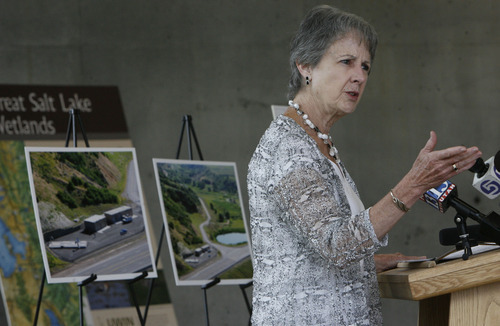This is an archived article that was published on sltrib.com in 2011, and information in the article may be outdated. It is provided only for personal research purposes and may not be reprinted.
Kaysville • The federal government plans to tap into the private sector to bring more clean energy to Utah.
Assistant Interior Secretary Anne Castle announced Tuesday that her agency will reach out to private investors to build a hydropower plant along the Spanish Fork River — the first of about a half dozen such water power projects planned for Utah.
Castle describes the initiative as an affordable way to push the nation toward increased reliance on renewable energy.
"Adding hydropower capability at existing facilities is a cost-effective and environmentally sustainable way to build our clean-energy portfolio, create local jobs and stimulate the economy," Castle said, making her announcement Tuesday at Utah State University's Wetland Discovery Point in Kaysville.
The proposed power plant would be built near Diamond Fork in Spanish Fork Canyon, where the Central Utah Project (CUP) now runs a flow-control facility. Federal officials estimate that a hydropower plant at that location could generate enough electricity — about 23,000 megawatt hours a year — to supply power to nearly 2,500 homes.
Reed Murray, a CUP program director, hopes private-sector involvement will hasten hydropower in Utah with projects that may not have been possible with public funds.
"This is a great opportunity to partner with private developers and have them come up with the funds to put the power in place," he said. "It can accelerate the development. It is a win-win situation for private developers and for the United States."
Interior has identified 70 possible hydropower projects in 14 Western states. Seven of those projects are in Utah at water-control facilities such as the Starvation and Soldier Creek dams.
If hydropower plants were built at each of those proposed Utah locations, Interior estimates that the Beehive State could produce more than 220,000 megawatt hours of electricity a year. That's enough to light up 23,600 homes for a year, based on the energy output needed for an average Utah household.
"We're focused on moving our nation toward a clean-energy economy," Castle said, "that incorporates more renewables."
Zach Frankel, executive director of the Utah Rivers Council, disputed the notion that hydropower is "clean energy" and warned that the project could damage Spanish Fork Canyon's ecosystem.
"It is going to impact the area," he said. "Let's not pretend that it doesn't."
Frankel urged the nation to focus more on conserving energy and eliminating waste than on creating more sources of power generation.
Starting this week, federal officials will collect proposals from private investors interested in the hydro project. The deadline for the proposals is mid-October.
jstettler@sltrib.com Twitter: Stettler_Trib —
By the numbers: Spanish Fork River hydro plant
22,920 Megawatt hours that could be generated annually at the proposed plant.
2,453 Homes that could be powered for a year with that much electricity, based on the energy use of an average Utah household.
70 Possible locations the Interior Department is considering for hydropower in the West.
7 Number of Utah locations, including newly announced project in Spanish Fork Canyon.



